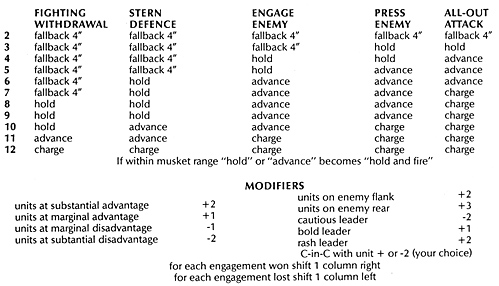I have always thought that the most creative aspect of our hobby was the creation and development of rules and systems. To take the actions of historic bodies of men and imitate them using a couple of pages of rules, dice and a 12 inch ruler takes some imagination and thought. Solowargaming rules represent, for me, even more of a challenge. Not only must the rule system be playable and historic but these rules must reach a fine balance between random events and player controlled activities. I have a number of solo games ranging from the ones where the dice play the game and you are an interested spectator, to the ones where the player virtually controls both sides himself, knowing every move and counter-move.
In a past issue of THE COURIER, (VI-3), WalterSimon outlined a system of skirmish rules whereby the players, at times, lost control of their figures due to morale. At the end of the article he suggested that the system might be useful for battalion level games. The thought fascinated me. After months of research, training and development this concept is ready for unveiling. The system can be used for a 2 player game, but it is especially suited for solo play.
At the beginning of each game a player issues orders for the units he controls. These orders outline where the unit(s) are to move and also what attitude they shall adopt once contact (twice musket range) has been made with the enemy. Once within the contact range the player MUST roll for the unit's move, on the following chart, based on how aggressive the units have been told to be, its situation and its leader.
Usually all goes as planned. But occasionally the subordinate officer takes matters into his own hands. Our group finds it very realistic to be able to direct the actions of troops UP UNTIL they get within a critical distance of the enemy. Then you see how well they follow your orders. I once had a battalion of highlanders, who I had ordered to stand solid in defence of a ridge, fix bayonettes and charge everything in sight. They won t;ie battle for me... but that's beside the point - it wasn't the way I wanted to win it. We allow players to change orders but only with a dice generated time lag, which often makes it too late to be of any use.
For solo gaming I make up a bunch of index cards with the map of the table, situation and objectives on one side and the size of brigades and orders, including attitude, on the other. I have a set of random generation charts so I only hve to note troop size by; infantry-large, cavalry-medium, etc. and then roll on the appropriate chart. This gives me unlimited variations from the same card, which I keep for later use. I'll make up 5 or so for each map. Usually 3 or 4 obvious ones and a real dilly, I'll then file them with ones I've made in months and years gone by and let them sit while I forget what I had planned.
When I'm stuck for a live opponent or when I just feel like a solo game I draw a card and read the situation and map. After I've brought my army and issued orders I can look on the back and see what "he" has planned. The play continues as usual with the tactics charts controlling BOTH sides once units are in contact. Even if my plan is perfectly suited to stopping "him" my units may not act the way I wish, or "his" units may be more stubborn or aggressive than they have a right to be.
I have only played with this system using Barry Gray's Koenig Kreig rules but I don't see why any other set couldn't be used with just a little tinkering. So, make up some cards, file them away and while you wait you can give a lecture series to your highland troops on the importance of following orders.

Back to Table of Contents -- Courier Vol. VIII No. 6
To Courier List of Issues
To MagWeb Master Magazine List
© Copyright 1989 by The Courier Publishing Company.
This article appears in MagWeb (Magazine Web) on the Internet World Wide Web.
Other articles covering military history and related topics are available at http://www.magweb.com